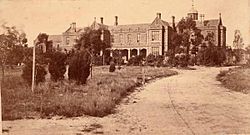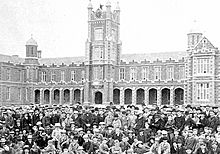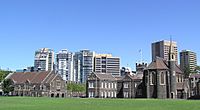Melbourne Grammar School facts for kids
Quick facts for kids Melbourne Grammar School |
|
|---|---|
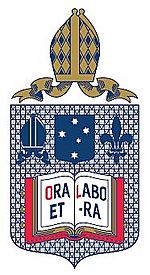 |
|
| Location | |
|
South Yarra, Caulfield and Port Melbourne (Sports)
,
Australia
|
|
| Coordinates | 37°50′2″S 144°58′34″E / 37.83389°S 144.97611°E |
| Information | |
| Type | private school, co-educational primary, single-sex boys secondary, day and boarding, Christian school |
| Motto | Latin: Ora et Labora (Pray and Work) |
| Denomination | Anglican |
| Established | 1849 (on present site since 1858 – the celebrated date of foundation) |
| Founder | Charles Perry, 1st Anglican Bishop of Melbourne |
| Chairman of Governors | Andrew Michelmore |
| Headmaster | Philip Grutzner |
| Chaplain | Hugh Kempster |
| Gender | Co-educational (P–6) Boys (7–12) |
| Enrolment | 1,782 (P–12) |
| Houses | Bromby, Bruce, Creese, Deakin, Hone, Morris, Miller, Perry, Ross, Rusden, School, Witherby |
| Colour(s) | Oxford Blue (Navy) |
| Fight song | Play Together Dark Blue Twenty |
| Affiliation | Associated Public Schools of Victoria G20 Schools |
| Alumni | Old Melburnians |
Melbourne Grammar School is a well-known Australian private school connected to the Anglican Church. It offers classes for students who go home each day (day school) and for students who live at the school (boarding school).
The school has three main campuses. Grimwade House is for younger students from Prep to Year 6 and is co-educational, meaning both boys and girls attend. Wadhurst is for boys in Years 7 and 8, and the Senior School is for boys in Years 9 to 12. The school has about 1,900 students in total.
Melbourne Grammar is part of many school groups, including the Associated Public Schools of Victoria (APS). It is famous for educating three of Australia's former prime ministers: Alfred Deakin, Stanley Bruce, and Malcolm Fraser.
Contents
The Story of Melbourne Grammar
The school's story began in 1849 with a small grammar school in East Melbourne. It was started by Melbourne's first Anglican bishop, Charles Perry, to provide education for the growing city. This first school didn't last long and closed in 1854.
However, Bishop Perry still dreamed of a large, permanent school like the famous public schools in England. In 1855, he was granted 15 acres (6.1 ha) of land on St Kilda Road. This is where the Senior School and Wadhurst are located today, near the Royal Botanic Gardens.
The foundation stone was laid in 1856, and the Melbourne Church of England Grammar School officially opened on 7 April 1858. It started with 76 students and Dr. John E. Bromby as the first headmaster.
The school faced many challenges in its early years. In the 1890s, a tough economic time called a recession caused student numbers to drop. To help save the school, a group of former students created The Old Melburnians Society in 1895. This group helped bring old friends together and support the school.
By the early 1900s, the school was doing much better. A major addition was the Chapel of St Peter, built in 1893. It was the first school chapel in the colony of Victoria.
During World War I, hundreds of former students went to fight, and sadly, over 200 did not return. During World War II, the army used some of the school buildings, and students had to squeeze into crowded classrooms.
By the 1950s, the school needed more space. It began a major building program and started buying nearby properties. In 1986, the school made a big change. Grimwade House began teaching both girls and boys from Prep to Year 6, while Wadhurst became a school just for boys in Years 7 and 8.
In 2008, for its 150th anniversary, the school opened the Nigel Peck Centre for Learning and Leadership.
Headmasters of the School
A headmaster is the person in charge of the school. Melbourne Grammar has had many headmasters since it opened.
| Period served | Name |
|---|---|
| 1858–1875 | John Edward Bromby |
| 1875–1883 | Edward Ellis Morris |
| 1883–1885 | Alexander Pyne |
| 1885–1893 | Ambrose John Wilson |
| 1894–1898 | Frederic Sergeant |
| 1899–1914 | George Ernest Blanch |
| 1915–1936 | Richard Penrose Franklin (Henry Girdlestone acting 1917–19) |
| 1937–1938 | David Stacey Colman |
| 1938–1949 | Joseph Richard Sutcliffe |
| 1950–1970 | Sir Brian William Hone |
| 1970–1987 | Nigel Arthur Holloway Creese |
| 1988–1994 | Antony James de Villiers Hill |
| 1995–2009 | Andrew Paul Sheahan |
| 2009–2019 | Roy Kelley |
| 2020–present | Philip Grutzner |
School Campuses
Melbourne Grammar School is spread across seven different locations. Three are for regular classes, one is for sports, and three are for outdoor camps.
- Grimwade House – In Caulfield, for boys and girls from Prep to Year 6.
- Wadhurst – In South Yarra, for boys in Years 7 and 8.
- Senior School – In South Yarra, for boys in Years 9 to 12.
- Edwin Flack Park – In Port Melbourne, a large sports area.
- Camp Dowd – On the Gippsland Lakes, for Year 8 camps.
- Robert Knox Camp – In Woodend, for camps for Years 5 to 7.
- L.G.Robertson Camp – At Breakfast Creek, for camps for Years 9 to 12.
The House System
In 1914, the school created a house system to encourage students to get involved in sports. A "house" is like a team that students belong to for their whole time at the school. Originally, there were six houses.
Students were put into houses based on where they lived. For example, boys from Toorak were in Bromby House, and boys from South Yarra were in Rusden House. The houses competed in sports like cricket, rowing, and football to win the "Cock House" championship.
In the 1950s, Headmaster Brian Hone changed the focus of the houses. He wanted them to be less about just winning sports and more about looking after students' well-being and building character.
Over the years, more houses were added. Today, there are twelve houses in the Senior School. Wadhurst has its own five houses: Caffin, Cain, Cuming, Wilhelm, and Brookes.
Learning at Melbourne Grammar
Students in Years 11 and 12 study for the Victorian Certificate of Education (VCE). This is the main high school certificate in Victoria. Melbourne Grammar students often achieve very high scores.
For many years, several students have received the top possible ATAR score of 99.95. The ATAR is a rank used by universities to select students. In 2009, a record seven students achieved this perfect score. The school consistently performs well academically.
| Year | Rank | Median study score | Scores of 40+ (%) | Cohort size |
|---|---|---|---|---|
| 2012 | 27 | 35 | 24.6 | 389 |
| 2013 | 29 | 35 | 27.9 | 383 |
| 2014 | 29 | 35 | 24.2 | 393 |
| 2015 | 41 | 34 | 22.0 | 386 |
| 2016 | 42 | 34 | 22.7 | 369 |
| 2017 | 42 | 34 | 22.8 | 379 |
| 2018 | 12 | 36 | 27.5 | 374 |
| 2019 | 28 | 35 | 23.7 | 388 |
| 2020 | 41 | 34 | 23.4 | 373 |
| 2021 | 21 | 35 | 24.5 | 371 |
| 2022 | 21 | 35 | 25.8 | 377 |
| 2023 | 20 | 35 | 27.1 | 385 |
Activities Outside the Classroom
Debating
Melbourne Grammar students compete in debating against other schools like Scotch College and Sydney Grammar. They also take part in the Debaters Association of Victoria's (DAV) competition and have won several championships.
Music
The school's main orchestra, the Melbourne Grammar School Symphony Orchestra (MGSSO), travels to other countries to perform. It has toured places like China, Japan, France, and the United States. The orchestra is made up of about 100 students. The school also has choirs, bands, and other music groups.
Sport
Sport is a very important part of life at Melbourne Grammar.
The Cordner–Eggleston Cup
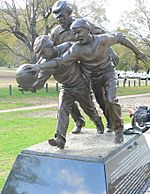
This is a famous Australian Rules Football match played every year against Scotch College. The tradition started in 1858 with the first-ever recorded game of Aussie Rules. This makes it the oldest continuing school football competition in the world.
Rowing
Melbourne Grammar has a strong history in rowing. The school has won the famous Head of the River race 28 times. In 2016, the winning crew even went to the UK to compete in the Henley Royal Regatta.
Other Sports
The school competes in many other sports, including athletics, soccer, basketball, cricket, hockey, and volleyball. It has won many premierships (championships) in the Associated Public Schools (APS) competition. The school has also produced professional athletes who have played in the A-League and for overseas clubs.
APS Premierships Won
Melbourne Grammar has won many championships in the APS competition.
- Athletics: 30 times
- Cricket: 37 times
- Football: 35 times
- Hockey: 8 times
- Rowing: 28 times
- Volleyball: 3 times
- Water Polo: 6 times
Theatre
The school has a strong drama department. Each year, it puts on several plays, often with students from the nearby sister school, Melbourne Girls Grammar School.
The biggest plays are the Quad Play, which is often a Shakespeare play performed outdoors, and the School Play, which is a major musical or drama. Past shows have included Romeo and Juliet, The Pirates of Penzance, and Guys and Dolls.
School Symbols
Crest and Motto
The school's motto is Ora et Labora, which is Latin for "Pray and Work". This motto was chosen in 1875 and shows the importance of both faith and hard work at the school.
The school crest includes several symbols:
- A mitre (a bishop's hat) shows the school's link to the Anglican Church.
- An open book stands for knowledge.
- The Fleur de Lys (a type of lily) is a symbol of purity.
- The Southern Cross represents Australia.
Fight Song
The school's fight song is called "Play Together, Dark Blue Twenty". The lyrics were written in the 1880s and are sung to the tune of "Men of Harlech". The song cheers on the school's teams in football, cricket, and rowing.
Alumni
Former students of Melbourne Grammar School are called "Old Melburnians". Many have become famous leaders, athletes, and artists.
See also
- List of schools in Victoria
- List of high schools in Victoria
- Old Melburnians Football Club


